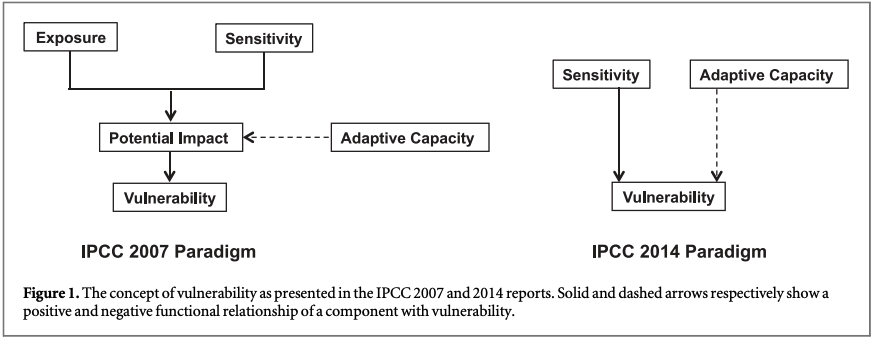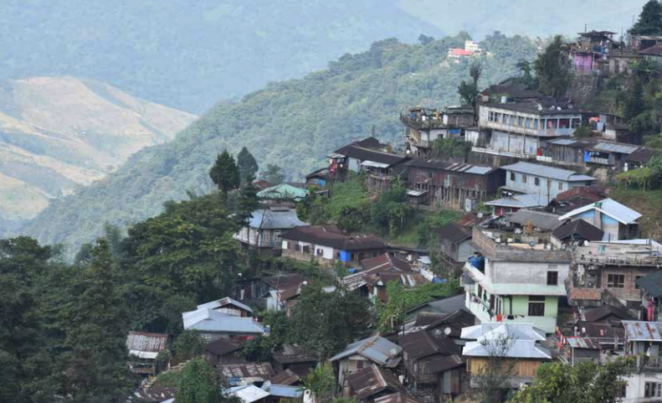Article /
Applying the IPCC 2014 framework for hazard-specific vulnerability assessment under climate change

Introduction
The single most important purpose in addressing climate change is to reduce the risks to natural and social systems arising from it. The Intergovernmental Panel on Climate Change (IPCC) Working Group (WG) II Report (2014) provides an impact-risk framework that can be applied to this end.
In the IPCC 2014 framework, the risk of impact from climatic and non-climatic hazard(s) is caused by the interaction of hazard, exposure and vulnerability. The framework thus separates vulnerability from the concepts of hazard and exposure, presenting it as a characteristic internal property of a system and not one that is directly linked to exposure to hazard. In this way the IPCC 2014 report is a paradigm change from IPCC 2007 report.
This change in how vulnerability is conceptualised has implications for assessing vulnerability. Under IPCC 2014 framework, indicators for only sensitivity and adaptive capacity are selected to assess vulnerability. Whereas, under IPCC 2007 report, vulnerability is presented as a consequence of the interaction of exposure, sensitivity and adaptive capacity, and so indicators for all the three are selected to assess it. A comparison of the concept of vulnerability in 2007 and 2014 reports is shown in figure 1.
Under this changed paradigm of 2014 report, vulnerability assessment studies are grappling to address the question— Vulnerability to what? Because, while the vulnerability is presented as not-dependent on exposure and hazard, the decision-makers and planners want to know the vulnerability of natural and social systems to climatic hazards such as landslide or drought or unseasonal rainfall.
This paper* analyzes the changes in the concept of vulnerability from the IPCC 2007 to the 2014 report. It then discusses this question – Vulnerability to what? – and the implications of these two different understandings of vulnerability for undertaking vulnerability assessment. It finds that though vulnerability under IPCC 2014 report is shown not to be dependent on hazard, it is still assessed in the context of an anticipated hazard by selecting ‘hazard-relevant’ indicators for sensitivity and adaptive capacity of a system. The authors argue that the use of ‘new paradigm’ to understand and assess vulnerability offers a robust approach for vulnerability and risk reduction under an uncertain future.
This paper was published in Environmental Research Communications in May 2019. This work contributed to the development of a common framework for assessing the vulnerability to climate change in 12 Himalayan states and an associated geoportal providing easy access to vulnerability data and maps for use by different stakeholders in the Indian Himalayan Region (IHR), for research and planning. See the article ‘Climate Vulnerability and Risk Assessment: Framework, Methods and Guidelines‘ for further detail on how this framework was developed and guidance on how to apply it. The results of this vulnerability and risk assessment can be found in ‘Climate Vulnerability Assessment for the Indian Himalayan Region Using a Common Framework‘. This work was initiated under the remit of the Indian Himalayas Climate Adaptation Programme.
*Download the full paper form the right-hand column. A summary of the key messages and outcomes can be found below.
Key Messages
- The Intergovernmental Panel on Climate Change (IPCC), Working Group II Report (2014) presents vulnerability as a pre-existing characteristic property of a system. Accordingly, indicators for ‘sensitivity’ and ‘adaptive capacity’, which are internal properties of a system, are employed to assess it. Comparatively, the IPCC 2007 report includes ‘exposure’, an external factor, as the third component of vulnerability.
- The ‘new paradigm’ presented by the IPCC 2014 report to understand vulnerability as an internal property of a system enables assessment of ‘hazard-specific’ vulnerability by selecting ‘hazard-relevant’ indicators for ‘sensitivity’ and ‘adaptive capacity’. Such assessment offers more fundamental treatment of vulnerability and a robust approach for vulnerability and risk reduction under an uncertain future. It is also practically more useful, as the results of assessment and the indicators selected to assess vulnerability can be analyzed to identify the drivers of vulnerability.
- Addressing the drivers of vulnerability offers a reliable approach to reduce the current vulnerability and manage potential risk(s). Under climate change, strengthening the health status of a natural or social system to enhance its resilience potential is a robust and field-based approach, whether or not there are climatic and/or non-climatic impacts.
- Hazard-specific indicators for sensitivity and adaptive capacity can be used to operationalize the concept of vulnerability. This paper shows how the novel concepts of ‘selecting hazard relevant vulnerability indicators’ and ‘assessing hazard-specific vulnerability’ improves the contextualization of an assessment and thereby the acceptability of assessment results by the stakeholders.
Assessment under the ‘new paradigm’
Adopting the IPCC 2014 report’s approach, the practical assessment of vulnerability looks at the current system’s weaknesses and its lack of capacity to deal with the adverse impacts from exposure to a hazard.
This ‘new paradigm’ thus adopts a ‘starting point’ approach to assess vulnerability, while the ‘old paradigm’ (IPCC 2007) assesses vulnerability as the impact of an anticipated hazard. Assessment under the ‘old paradigm’ directly accounts for exposure (to a hazard) by selecting indicators for exposure. Thus under the ‘old paradigm’, the assessment team essentially has to start with defining hazard in terms of its nature and intensity. This typically requires past hazard-based and model-based information that at best enables an approximation of the anticipated hazard, and thus involves uncertainty.
Such uncertainty is avoided under the ‘new paradigm’, as indicators for exposure to hazard are not employed to assess vulnerability. Instead, hazard-relevant indicators for sensitivity and lack of adaptive capacity are employed. From this fundamental difference in the approach to assess vulnerability under the two paradigms, it is seen that vulnerability assessment adopting the ‘new paradigm’ is distinctly advantageous over the ‘old paradigm’ for reducing vulnerability in actual life. Such advantages include the following:
- The ‘Old paradigm’ considers a system in the aftermath of a hazard occurrence, when the opportunity to reduce vulnerability is limited to addressing the impact(s) of hazard. However, the ‘new paradigm’ considers a system in anticipation of a hazard thus enlarging the scope for reducing vulnerability to both, before and after hazard occurrence.
- Unlike the ‘old paradigm’, the focus under the ‘new paradigm’ is on the system and not on the impact(s) of hazard on the system. This provides for treating the system weaknesses and thereby restoring its potentially best-resilient internal state. This is particularly advantageous in case of natural systems such as forests and oceans, as otherwise their scale and spontaneity permit limited scope for human assisted adaptation.
- As the adaptation measures identified by adopting the ‘new paradigm’ are based in addressing the current weaknesses of a system and the stresses impacting it, the scope for maladaptation is minimized. This is an imporvement over the ‘old paradigm’, where uncertainty associated with the (exposure to) hazard data increased the potential for maladaptation.
- Under the ‘new paradigm’, it is the current status of the health of a system and the factors impacting it that are in focus, and as these can be both demonstrated to and appreciated by the stakeholders, the assessment easily becomes participatory and hence acceptable, reliable and actionable.
- Overal, vulnerability assessment adopting the ‘new paradigm’ (starting point approach) is more useful than that carried out using the ‘old paradigm’ or the ‘end point’ approach, where ‘uncertainties in the climate scenarios, climatic effects on sectors, and future socio-economic conditions’ make it ‘practically impossible to formulate specific climate change adaptation policies’(O’Brien et al 2004).
- The ‘new paradigm’ offers a ready opportunity for benchmarking the current status of a system of interest that may be under the risk from climate change.
- Restoring and strengthening the health of a system by addressing the sources of vulnerability identified by adopting the ‘new paradigm’ is a ‘no regrets policy’, as higher system performance is achieved whether or not there is threat from climate change.

Suggested citation
Sharma, J. and Ravindranath, N., H. (2019) Applying IPCC 2014 framework for hazard-specific vulnerability assessment under climate change. Environmental Research Communications. (1) 051004. DOI: https://doi.org/10.1088/2515-7620/ab24ed
- Learn more about the Indian Himalayas Climate Adaptation Programme
- Go to the Indian Himalayan Region (IHR) geoportal
- Read 'Climate Vulnerability Assessment for the Indian Himalayan Region Using a Common Framework'
- Read the manual: 'Climate Vulnerability and Risk Assessment for the Indian Himalayan Region' (2018)
